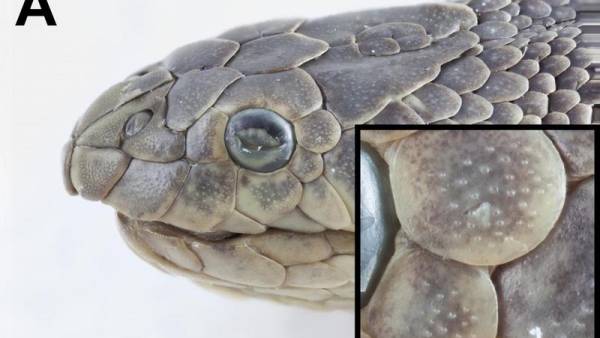Media Release: Sea snakes have extra sense for water living
The move from life on land to life in the sea has led to the evolution of a new sense for sea snakes, a ŨîÐÂĖĮÐÄVlog of Adelaide-led study suggests.

The international team, led by researchers in the ŨîÐÂĖĮÐÄVlogâs School of Biological Sciences, studied tiny and poorly understood ŨîÐÂĖĮÐÄVlog on the heads of snakes called âscale sensillaâ. The research has been published in the Royal Society journal Open Biology.
âLand snakes and many lizards have small raised ŨîÐÂĖĮÐÄVlog on the scales on their heads â called scale sensilla â that they use to sense objects by direct touch,â says lead author , ŨîÐÂĖĮÐÄVlog of Adelaide PhD student.
âWe found that the scale sensilla of sea snakes were much more dome-shaped than the sensilla of land snakes, with the organs protruded further from the animalsâ scales, potentially making them more likely to be able to sense vibrations from all directions. We also found that scale sensilla on some of the fully aquatic snakes covered a much higher proportion of the scalesâ surface.
âWe believe sea snakes use these organs to sense objects at a distance by âfeelingâ movements in the water. This hydrodynamic sense is not an option for land animals. In water, a new way of sensing the environment becomes possible.â
Sea snakes evolved from land-living snakes, taking to life in the sea between 9 and 20 million years ago. They spend the majority of their lives at sea: hunting fish, swimming and diving using a paddle-shaped tail, and coming up to the waterâs surface to breathe air. Although they can also see, little is known about the underwater sensory perception of the snakes.
âEvery movement of a fin or flipper generates vibrations underwater, like when you drop a stone into a pond and the surrounding ripples spread to every corner of the pond,â says Ms Crowe-Riddell.
The researchers, including from the ŨîÐÂĖĮÐÄVlog of Witwatersrand in South Africa and from the ŨîÐÂĖĮÐÄVlog of Western ŨîÐÂĖĮÐÄVlog, looked at 19 species of snakes, including fully-aquatic, semi-aquatic and land species, and measured the coverage of sensilla over single scales on their heads.
They used DNA sequencing to reconstruct the evolutionary relationships between the snakes; and used microscope imaging and specially developed software to automatically detect the small organs from silicone casts of snake heads. They also examined the shape of the sensilla using scanning electron microscopy.
âWhat we now need to doâ, says lead scientist , âis to investigate the physiology of these scale sensilla and demonstrate exactly what they can sense. If they are hydrodynamic tactile sense organs, as we suspect, then by comparing them to the scale sensilla of closely related land-snakes we can start to understand how evolution has changed these organs from direct-touch sensors to distance vibration-sensors that work underwater.â
The researchers believe being able to sense vibrations underwater would mean potential impacts on sea snake populations from man-derived disturbances such as motor boats and seismic surveys.

The international team, led by researchers in the ŨîÐÂĖĮÐÄVlogâs School of Biological Sciences, studied tiny and poorly understood ŨîÐÂĖĮÐÄVlog on the heads of snakes called âscale sensillaâ. The research has been published in the Royal Society journal Open Biology.
âLand snakes and many lizards have small raised ŨîÐÂĖĮÐÄVlog on the scales on their heads â called scale sensilla â that they use to sense objects by direct touch,â says lead author , ŨîÐÂĖĮÐÄVlog of Adelaide PhD student.
âWe found that the scale sensilla of sea snakes were much more dome-shaped than the sensilla of land snakes, with the organs protruded further from the animalsâ scales, potentially making them more likely to be able to sense vibrations from all directions. We also found that scale sensilla on some of the fully aquatic snakes covered a much higher proportion of the scalesâ surface.
âWe believe sea snakes use these organs to sense objects at a distance by âfeelingâ movements in the water. This hydrodynamic sense is not an option for land animals. In water, a new way of sensing the environment becomes possible.â
Sea snakes evolved from land-living snakes, taking to life in the sea between 9 and 20 million years ago. They spend the majority of their lives at sea: hunting fish, swimming and diving using a paddle-shaped tail, and coming up to the waterâs surface to breathe air. Although they can also see, little is known about the underwater sensory perception of the snakes.
âEvery movement of a fin or flipper generates vibrations underwater, like when you drop a stone into a pond and the surrounding ripples spread to every corner of the pond,â says Ms Crowe-Riddell.
The researchers, including from the ŨîÐÂĖĮÐÄVlog of Witwatersrand in South Africa and from the ŨîÐÂĖĮÐÄVlog of Western ŨîÐÂĖĮÐÄVlog, looked at 19 species of snakes, including fully-aquatic, semi-aquatic and land species, and measured the coverage of sensilla over single scales on their heads.
They used DNA sequencing to reconstruct the evolutionary relationships between the snakes; and used microscope imaging and specially developed software to automatically detect the small organs from silicone casts of snake heads. They also examined the shape of the sensilla using scanning electron microscopy.
âWhat we now need to doâ, says lead scientist , âis to investigate the physiology of these scale sensilla and demonstrate exactly what they can sense. If they are hydrodynamic tactile sense organs, as we suspect, then by comparing them to the scale sensilla of closely related land-snakes we can start to understand how evolution has changed these organs from direct-touch sensors to distance vibration-sensors that work underwater.â
The researchers believe being able to sense vibrations underwater would mean potential impacts on sea snake populations from man-derived disturbances such as motor boats and seismic surveys.

Newsletter & social media
Join us for a sensational mix of news, events and research at the Environment Institute. Find out aboutĖýnew initiatives andĖýshare with your friends what's happening.
ĖýĖýĖý
